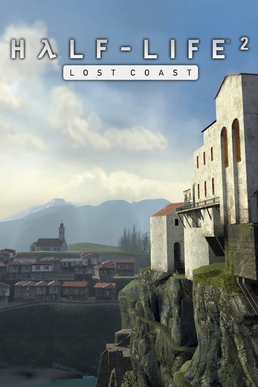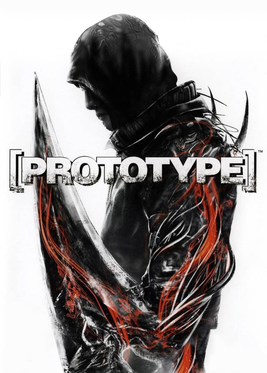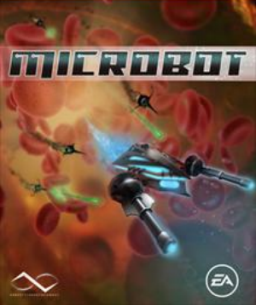
Half-Life 2: Lost Coast is an additional level for the 2004 first-person shooter game Half-Life 2. Developed by Valve, it was released on October 27, 2005, as a free download for owners of Half-Life 2 on Steam. Players control Half-Life protagonist Gordon Freeman as he travels up a coastal cliff to destroy a Combine weapon in a monastery.

Stranglehold is a third-person shooter video game developed by Midway Studios – Chicago and Tiger Hill Entertainment and published by Midway Games. It was released in late 2007 for Microsoft Windows, PlayStation 3 and Xbox 360. It is Midway's first game to use Unreal Engine 3. Stranglehold is a sequel to John Woo's 1992 Hong Kong action film Hard Boiled and stars Chow Yun-fat in a reprisal of his role as hard-boiled cop Inspector "Tequila" Yuen. Stranglehold is the first project on which Woo and Chow have collaborated since Hard Boiled. The game received generally positive reviews from critics and sold more than one million units worldwide.
A beat 'em up is a video game genre featuring hand-to-hand combat against a large number of opponents. Traditional beat 'em ups take place in scrolling, two-dimensional (2D) levels, while a number of modern games feature more open three-dimensional (3D) environments with yet larger numbers of enemies. The gameplay tends to follow arcade genre conventions, such as being simple to learn but difficult to master, and the combat system tends to be more highly developed than other side-scrolling action games. Two-player cooperative gameplay and multiple player characters are also hallmarks of the genre. Most of these games take place in urban settings and feature crime-fighting and revenge-based plots, though some games may employ historical, science fiction or fantasy themes.

Ridge Racer 7 is a 2006 arcade-style racing video game developed and published by Namco Bandai Games for the PlayStation 3 as a launch title. The seventh installment in the Ridge Racer series for consoles, Ridge Racer 7 is essentially the PlayStation exclusive version of the Xbox 360 exclusive Ridge Racer 6, but with more content.

The Orange Box is a video game compilation containing five games developed and published by Valve. Two of the games included, Half-Life 2 and its first stand-alone expansion, Episode One; had previously been released in 2004 and 2006 as separate products. Three new games were also included in the compilation: the second stand-alone expansion, Half-Life 2: Episode Two; the puzzle game Portal; and Team Fortress 2, the multiplayer game sequel to Team Fortress Classic. Valve also released a soundtrack containing music from the games within the compilation. A separate product entitled The Black Box was planned, which would have included only the new games, but was later canceled.

Everyday Shooter is a multidirectional shooter video game developed and published by Queasy Games for Windows.

Prototype is a 2009 action-adventure video game developed by Radical Entertainment and published by Activision. It was released in June 2009 for the PlayStation 3, Xbox 360, and Microsoft Windows. In July 2015, the game was re-released alongside its sequel as the Prototype Biohazard Bundle for the PlayStation 4 and Xbox One. Separate versions of the two games became available in August 2015. In Prototype, players control an amnesiac shapeshifter named Alex Mercer as he attempts to stop an outbreak of a virus called Blacklight in Manhattan, which mutates individuals into powerful, violent monsters. Alex also attempts to uncover his mysterious past while coming into conflict with both the US military and a black operations force called Blackwatch. Outside of the main story, players can freely explore the game's open world and engage in several different side activities.

Braid is an indie puzzle-platform video game developed by Number None. The game was originally released in August 2008 for the Xbox 360's Xbox Live Arcade service. Ports were developed and released for Microsoft Windows in April 2009, Mac OS X in May 2009, PlayStation 3 in November 2009, and Linux in December 2010. Jonathan Blow designed the game as a personal critique of contemporary trends in video game development. He self-funded the three-year project, working with webcomic artist David Hellman to develop the artwork.

Galaga Legions is a 2008 twin-stick shooter video game developed and released by Namco Bandai Games for the Xbox 360. It is the twelfth game in the Galaxian series, and the third developed for home platforms. The player controls a starship, the AEf-7 "Blowneedle", in its efforts to wipe out the Galaga armada. The objective of the game is to clear each of the five stages as quick as possible. Stages have a heavy emphasis on puzzle solving and chain reactions, which are necessary to clear out enemy formations. The Blowneedle has a pair of satellites at its disposal, and can place them anywhere on the screen to fend off enemies.

Spore is a 2008 life simulation real-time strategy god game developed by Maxis and published by Electronic Arts for Microsoft Windows and Mac OS X. Designed by Will Wright, it covers many genres including action, real-time strategy, and role-playing games. Spore allows a player to control the development of a species from its beginnings as a microscopic organism, through development as an intelligent and social creature, to interstellar exploration as a spacefaring culture. It has drawn wide attention for its massive scope, and its use of open-ended gameplay and procedural generation. Throughout each stage, players are able to use various creators to produce content for their games. These are then automatically uploaded to the online Sporepedia and are accessible by other players for download.

In video games, an open world is a virtual world in which the player can approach objectives freely, as opposed to a world with more linear and structured gameplay. Notable games in this category include The Legend of Zelda (1986), Grand Theft Auto V (2013) and Minecraft (2011).

Spore Galactic Adventures is an expansion pack for the multigenre game Spore, developed by Maxis Emeryville and published by Electronic Arts. The US version of the game was released on June 23, 2009. The European version was released on June 26, 2009.

Vanquish is an action third-person shooter video game developed by PlatinumGames and published by Sega for the PlayStation 3 and Xbox 360. It began development in 2007 and was released worldwide in October 2010. A Windows port was released on May 25, 2017. A compilation titled Bayonetta & Vanquish 10th Anniversary Bundle was released for PlayStation 4 and Xbox One on February 18, 2020, including remastered versions of the game and PlatinumGames' Bayonetta.

MicroBot is a twin-stick shooter video game developed by Naked Sky Entertainment and published by Electronic Arts. It was released on the Xbox 360 via Xbox Live Arcade on December 29, 2010, and on PlayStation 3 via the PlayStation Network in 2011. In the game the player controls a MicroBot; a microscopic robot designed to combat infections in the human body. The robot is tasked with destroying previous generation MicroBots which have become corrupted while fighting disease in the body.

Choplifter HD is a video game developed by inXile Entertainment and released in 2012–2013. It is a 3D polygonal remake of the 1982 game Choplifter by Dan Gorlin. inXile hired Gorlin as a design consultant for the game. As in the original game, players fly missions in a helicopter, defeating enemies and rescuing people. Initially released for Windows, Xbox 360, and PlayStation 3, the game was later ported to Ouya and Android devices. Choplifter HD was praised for staying true to the original, retaining the gameplay the series was known for, but was criticized for its high level of difficulty.
Resogun is a shoot 'em up video game developed by Housemarque and published by Sony Computer Entertainment for the PlayStation 4. It was originally released in North America and PAL regions in November 2013, while ports for PlayStation 3 and PlayStation Vita developed by Climax Studios were released in December 2014. Resogun: Heroes, the first downloadable content (DLC), was released in North America on June 24, 2014, while the second DLC, Resogun: Defenders was released on February 17, 2015. Resogun draws heavily from the games Defender and Datastorm, and is considered the spiritual successor to Housemarque's previous shoot 'em up games Super Stardust HD and Super Stardust Delta.

Dr. Luigi is a 2013 puzzle video game developed by Arika and Nintendo SPD, and published by Nintendo for the Wii U console. It is the sixth game in the Dr. Mario series and is part of the larger Mario franchise. The player must clear a field of invading viruses using pill capsules to eliminate them, in a tile-matching fashion. The game offers four modes: "Operation L", which utilizes L-shaped pills; "Virus Buster", using the Wii U GamePad and touchscreen; "Retro Remedy" with standard Dr. Mario gameplay; and local and online multiplayer options, online utilizing the defunct Nintendo Network Service.

Kameo: Elements of Power is a 2005 action-adventure video game developed by Rare and published by Microsoft Game Studios. The player controls Kameo, a 16-year-old elf, who must travel across the land, rescuing her family while collecting Elemental Sprites and Warriors in a beat 'em up style combat against the trolls that stand in her way. Kameo's ten elemental powers let her transform into creatures and use their varied abilities to solve combat-oriented puzzles and progress through the game's levels.

Turok is a first-person shooter video game developed by Propaganda Games, and published by Disney Interactive Studios under Touchstone Games. It was released for the PlayStation 3 and Xbox 360 in February 2008, and later ported on to Microsoft Windows in April. It was the only game produced under the Touchstone Games label.
A review bomb is an Internet phenomenon in which a large number of people or a few people with multiple accounts post negative user reviews online in an attempt to harm the sales or popularity of a product, a service, or a business. While a large number of negative reviews may simply be the result of a large number of customers independently criticizing something for poor quality, a review bomb may also be driven by a desire to draw attention to perceived political or cultural issues, perhaps especially if the vendor seems unresponsive or inaccessible to direct feedback. Review bombing also typically takes place over a short period of time and meant to disrupt established ratings that a product already has at review sites, sometimes backed by campaigns organized through online message boards. It may be used as a mass-movement-driven coercion tactic, as a form of protest, or may simply be a form of trolling. Review bombing is a similar practice to vote brigading.















